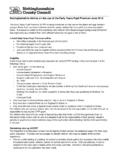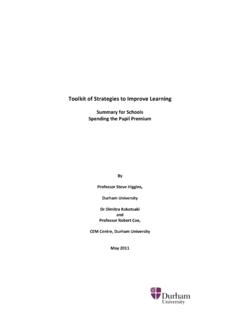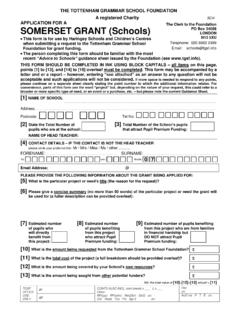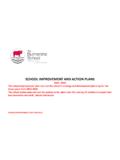Transcription of The Pupil Premium - assets.publishing.service.gov.uk
1 The Pupil PremiumHow schools are spending the funding successfully to maximise achievement In autumn 2012, Her Majesty s Inspectors visited 68 primary and secondary schools to see how effectively they were spending their Pupil Premium funding to maximise achievement. This report draws together some of the effective practice that inspectors saw. It is accompanied by a set of documents to help schools to analyse gaps in achievement and plan their actions effectively. ContentsForeword from Her Majesty s Chief Inspector 1 Introduction 2 Spending the Pupil Premium successfully to maximise achievement the overview 3 How schools maximised the impact of their spending 9 Targeting the funding well from the outset 9 Effective intervention classes and individual tuition to improve achievement in English and mathematics 11 Ensuring that teaching assistants help to raise standards 14 Minimising barriers to learning and achievement 18 Meeting individuals particular needs 20 The active involvement of governors 22 Effective monitoring and evaluation of the impact of spending 23 Carefully planned summer schools with a clear purpose 25 Notes 27
2 Further information 28 Annex A: Providers visited 291 The Pupil Premium : How schools are spending the funding successfully to maximise achievementThe Pupil Premium was introduced by the Coalition Government in April 2011 to provide additional support for looked after children and those from low income families. The extra funding is made available to schools to help them narrow the attainment gap that still exists between pupils from disadvantaged and more affluent Government asked Ofsted to investigate how effectively schools were using the additional funding. Last September, we published our initial findings and followed this up with nearly 70 visits throughout the autumn term to a range of primary and secondary schools.
3 These visits showed that some schools are still not spending the Pupil Premium on interventions that are having any meaningful impact. These schools do not have good enough systems for tracking the spending of the additional funding or for evaluating the effectiveness of measures they have put in place in terms of improving outcomes. In short, they struggle to show that the funding is making any real difference. There are, however, many schools that are getting this right, as this report explains and highlights. They have been able to tell my inspectors exactly where the Pupil Premium funding is being spent and can demonstrate how and why it is having an impact. The best school leaders know what they want to achieve from each of their interventions and they evaluate progress thoroughly to make sure these are working.
4 They also have well thought-through plans for building on their , many of these good schools are concentrating on the core areas of literacy and numeracy to break down the main barriers to accessing the full curriculum. They are also focusing on the key stages of a child s development in their school best primary schools are making sure that poorer children have all the help they need to grasp the basics of reading, writing and mathematics right at the start of their education so that they don t have to catch up later. The best secondary schools are finding out where the basic skills gaps exist among eligible pupils as soon as they arrive in Year 7 and deploying their best teachers to help close these gaps.
5 In particular, these schools are using the additional funding provided through the Pupil Premium to employ teachers with a good track record of working with disadvantaged pupils. The Government has also made a substantial sum of money available for secondary schools to run summer school programmes aimed at helping children from more disadvantaged backgrounds make a smooth transition from primary school to the next phase of their education. Schools have been invited to bid for a share of this funding rather than the money being allocated according to the Pupil Premium formula. The scheme was introduced with the very best of intentions. However, our survey work suggests that take up has to date been patchy and there is evidence of poor targeting of places and weak liaison between secondary and primary we know that the transition to secondary school is a key point in a child s education.
6 We know that pupils who start secondary school working below Level 4 in English and mathematics often struggle to access the curriculum. We know that they typically do not make as much progress as their peers. And we know that more disadvantaged pupils are in this group. Recently the Government announced that they will be giving extra funding to secondary schools to help to improve literacy levels in Year 7. We welcome this initiative. The Government should also consider diverting at least some of the summer school funding so that it goes directly to schools to pay for extra support for poorer pupils during this vital Year 7 period. This way, Ofsted will be able to properly monitor and report on whether this additional pot of public money is being used will continue to take an active interest in this issue in the coming months.
7 Our section 5 inspection reports will focus much more sharply on how well schools are using their Pupil Premium money. Where we find funding isn t being spent effectively on improving outcomes for disadvantaged pupils, we will be clear in our is vital that schools get this right. Every child who leaves school without the right qualifications faces a far more difficult path to fulfilling their potential and finding employment. We owe it to all our young people to ensure they are given every chance to from Her Majesty s Chief Inspector Pupil Premium was introduced in April 2011. It was allocated to children from low-income families who were known to be eligible for free school meals, and children who had been looked after continuously for more than six Eligibility for the Pupil Premium for 2012 13 was extended to pupils who have been eligible for free school meals at any point in the last six years (known as the Ever6 Free School Meals measure).
8 Schools also receive funding for children who have been looked after continuously for more than six months, and a smaller amount for the children of service Schools are free to spend the Pupil Premium as they see fit. However, they are accountable for how they use the additional funding to support pupils from low-income families and the other target groups. New measures have been included in the performance tables that show the achievement of pupils who attract the Pupil Premium . In September 2012 Ofsted published a report based on the views of 262 school leaders gathered through inspections and telephone-interview questionnaires conducted by Her Majesty s In the autumn term 2012, Ofsted followed up the findings of that survey by visiting a range of primary and secondary schools to see how effectively the schools were spending the funding to maximise achievement.
9 This report draws together some of the effective practice that inspectors observed. The schools that Ofsted visited for this survey had widely different allocations of Pupil Premium spending. For the primary schools visited, funding ranged from 2,400 to 83,896 in 2011/12 and from 4,200 to 134,323 in 2012/13 when the funding formula changed to include pupils who had been eligible for free school meals in the last six years (the Ever6 measure). Funding for the secondary schools visited ranged from 16,592 to 168,686 in 2011/12 and from 36,850 to 296,501 in 2012/13. But inspectors could see that however much funding the schools had, there were common characteristics to the most successful spending spending that had led to standards rising and opportunities broadening for the most disadvantaged pupils.
10 These characteristics are explained in this report, to help schools to consider how well they are spending their own allocation of the funding, and think about ways in which they could spend it even more effectivelyAccompanying this report is a booklet that contains a series of tools to help schools to analyse where there are gaps in achievement between pupils who are eligible for the Pupil Premium and those who are not, and to plan the action they need to Pupil Premium what you need to know, A Premium has also been introduced for children whose parents are currently serving in the Armed Forces, designed to address the emotional and social well-being of these pupils. This issue is not a focus for this For pupils eligible for free school meals and those looked after the amount was 488 in 2011 12 and 600 in 2012 13.















